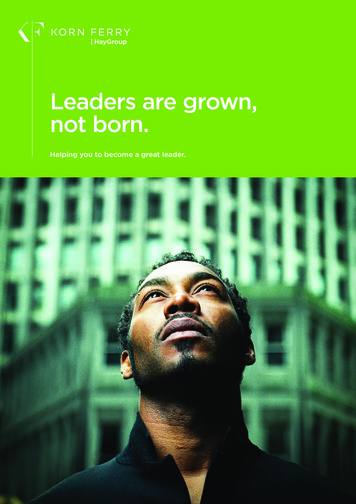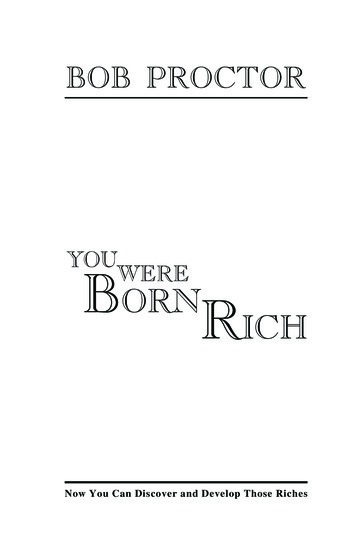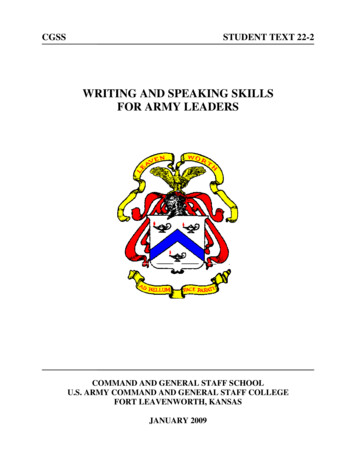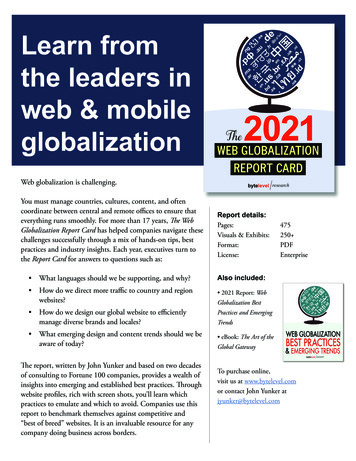
Transcription
Leaders are grown, not born. Leaders are grown,not born.Helping you to become a great leader.1
Leaders are grown, not born. Being a leader is tough.You’re the one who has to.handle conflict.hire the right people.train new recruits.manage performance.hold people accountable.give constructive feedback.promote your people to other areas.make sure your employees turn up.fill in the gaps if they don’t.deliver on quality standards.motivate your team to provide great service.produce more with less.manage costs.implement change.respond to each situation appropriately.deal with each team member appropriately.be ‘the company’ for your team.maintain your own motivation.1
Leaders are grown, not born. The good news is that great leaders aren’t born great;they become greatPoor leadership equals poor performance. So if leadership capabilityin your organization is low, your competition will either win yourbusiness or steal your best workers.However, you are more likely to survive the journey if you start with adesire to be the best leader you can be. Then find the motivation thatwill keep you going. Seek out feedback and support. Take risks andexperiment. Grasp opportunities to learn. Review your successes.Repeat the cycle.The truth is a great leader is measured by one criterion – teamperformance. And having looked at thousands of leaders across theworld – in business and in government, in industry and in healthcare,in retail and in education – we can tell you the four aspects of leadershipthat will make a difference to your team.Some peoplestart with the fearof failure. Andthe fear is a realone. A leaderimpacts teamperformancemore than anyother factor.Great leaders:1.2.create a greatatmosphereto work indon’t have one styleof leadership; theyhave several3.4.know when to usethe appropriate styleof leadershipknow exactlywhat their roleis in the teamBecoming a great leader doesn’t happen overnightIt’s a process that you will work on in the months and years to come.Feedback on your leadership behavior and impact can speed up theprocess and help you to focus your efforts.And it’s worth it. Leadership is about bringing out the best in others.It’s about delivering far more than you could deliver as a worker. It’sabout making a real difference.2
Leaders are grown, not born. It’s easier to get people to do things when theywant to do themYour leadership directly affects the way peoplefeel about working for you. You create what wecall a ‘climate’. This climate affects the amountof effort that people in your team will contribute.70%of the variance inteam climate canbe explained byleadership behavior.Our research shows that up to 70 per cent of the variance in climatecan be explained by leadership behavior. And a positive climate willincrease bottom-line performance measures by up to 30 per cent.So the more you improve their climate, the higher the performanceof your team will be.How do you do it?How can you create the best climate for your team? And how do youknow when you are doing it? After 60 years of study we know whichaspects of climate make the most difference. And our OrganizationalClimate Survey helps you measure the climate you are experiencingand the one you are creating for your team.We know which aspects of climate make themost difference.Six things that will make your people give their best:1. Clarity2. Standards3. FlexibilityThey are clear about wherethe organization is going andwhat their contribution is.There is a continual emphasison improvement andexcellence.There are no unnecessaryrules and procedures andgood ideas are acted upon.4. Responsibility5. Rewards6. Team commitmentThey are empowered to geton with their job and heldaccountable for it.They receive appropriaterecognition for their level ofcontribution.There is pride and trust inthe organization.Why does climate feedback matter so much?A poor climate indicates poor bottom line performance. Your teammembers’ climate feedback helps you to identify actions that willcreate the right conditions for them to give their best. And this willhelp you develop as a leader.3
Leaders are grown, not born. Now you know what climate is, what do you doto improve it?The next step is to look at how your behavior affectsthe climate for your team.Are you doing the right things, at the right time, with the right people,in the right situations?We have identified the six styles of leadership that have the biggestimpact on climate. And our Leadership Styles Survey helps youmeasure how you think you lead and how your team membersexperience your leadership.We measurethe six styles ofleadership thathave the biggestimpact on climate.Would your team agree that you are a great leader?Remember leadership styles impact climate. Your team’s feedbackon your leadership styles helps you to challenge your habits andassumptions. Developing your styles makes you more flexible in theway you lead. And you will get more out of your team by choosingthe most appropriate style for each situation you face.Six styles to choose from:VisionaryAffiliativeParticipativeA leader uses this style toprovide long term directionand vision. It provides clarity.It helps team members tounderstand what they needto do and how they need todo it. And – most importantly– it enables team membersto understand whytheir work matters.A leader uses the affiliativestyle to generate a warmand friendly atmosphere –to create harmony. It makesteam members feel valued asindividuals, not just workers.A leader uses this style togenerate commitment andconsensus among employeesand generate new ideas.It enables a team to build ashared vision. And to discussideas, make decisions andshare responsibility – together.CoachingPacesettingDirectiveA leader uses the coachingstyle to build long termcapability. It involves understanding team members’strengths, weaknesses andaspirations. Through coaching,a leader helps each teammember to be the bestthey can be.A leader uses pacesettingto get tasks done to a highstandard of excellence. Whenteam members don’t knowwhat to do, or how to do it,the leader who steps in anddoes is using this style.A leader uses this style todirect a task – and to demandimmediate compliance in itscompletion. It gives the teamclarity on what needs to bedone and how. But it doesn’texplain why.4
Leaders are grown, not born. But what makes great leaders do what they do?So you know what the climate is like in your team. And you knowwhich leadership styles you tend to use. But to broaden your choiceof styles, so you can use them flexibly, you need to understand yourown habits and resources.“ What do I do? andwhy do I do it?”You need to start asking two questions.1. Why do I behave in that way?Our behavior is driven by our motives and values. Understanding theseinner drivers allows us to predict, monitor and manage our behavior.And developing our ability to manage our natural responses gives ustime to choose the right leadership style, at the right time, with theright person.2. What helps me to behave differently?A bit of self-awareness goes a long way. When we know our strengths,we understand our choices. We can see how to apply a familiar skillto strengthen an under-used style. Understanding our emotionalintelligence makes our choices clearer to us.Are you an emotionally intelligent leader?Your emotional intelligence is the mix of personal abilities thatmake you an effective leader. Pioneer Daniel Goleman capturedthe essence of EI by stressing the importance of these four areas:1. Self-awareness3. Social awarenessKnowing your emotions andtheir effects. Being confidentin your abilities – andknowing their limits.Being sensitive – andresponsive – to otherpeople’s feelings, needsand requirements. Readingthe mood of a group.2. Self-management4. RelationshipmanagementKnowing how to manageyour emotions, how to keepdisruptive impulses in checkand stay poised and positive,even in difficult situations.An ability to influence others,handle conflict, develop, leadand work with others.These are the attitudes and behaviors that greatleaders use to drive personal and team performance.They go beyond academic qualifications, technicalskills and experience. And they support and sustainyour use of the full range of leadership styles.5
Leaders are grown, not born. What does your jobdemand of you?It is impossible to think about leading others withoutunderstanding the demands of your own job.What are the expectations of your boss, your team members, yourpeers, your customers? What does your role deliver to the team thatno other role does? What does fulfillment of your role look like?Don’t expect a perfect match. There is bound to be some tension,at some time, between you and your role. It’s valuable to understandwhat you strive for, what you enjoy, what you tend to avoid. And toidentify the areas where you feel confident, as a person, an expertand a leader.Comparing yourself with your role enables you toseek out the satisfactions, anticipate the frustrationsand manage your performance regardless.What are theexpectations ofyour boss, yourteam members,your peers,your customers?6
Leaders are grown, not born. Paul’s storyPaul was the head teacher/principal of the mostsuccessful school in his area.Then he took on – in addition – the leadership of afailing school nearby. Using climate, leadership stylesand competency assessments we collected feedbackfrom both schools.The results were surprisingThe same styles,two situations,very differentresults.The data from the failing school painted a picture of a motivatingclimate. The data from the successful school pointed to low morale.Yet Paul’s leadership style was the same in both schools. He waspacesetting and directive. So why were the climates so different?When we looked at what Paul enjoyed doing, it became clear that hisstrengths were in dealing with crises, rolling his sleeves up and settingvery clear directives. To the staff at the failing school this was a realbenefit. They were glad to be told what to do and how to sort outproblems. But the people in the successful school were tired of beingtold what to do – they were ready to take responsibility for theirown improvement.So Paul had a choice. Should he develop leadership styles that wouldbe good for a school that had achieved success? Or should he moveregularly and be the person who helped failing schools to turn around?There isn’t a right answer. But the feedbackoffered Paul insights into his behavior andchoices about change, when the circumstanceschanged around him.7
Leaders are grown, not born. Alex’s storyAs the general manager of one of the most importantbusiness units in Belron, Alex was shocked when shereceived her first set of leadership styles andclimate data.It showed she was relying heavily on two leadership styles: directive andpacesetting. The result, unsurprisingly, was to create a demotivatingclimate for her team; the feedback showed big gaps between what theteam needed to perform to the best of their abilities and what theyactually got from Alex.Great leadershiptakes time.Alex set a two year plan.and persistence paysWorking with her line manager (the CEO) and an internal Belron coach,she developed her behavior in a way that would drive a positive climate.But what about businessperformance over the two years?The business unit had been focusedon achieving significant expansionover the two years – both throughorganic growth and through acomplex acquisition. These requireda wide range of leadership skillsfrom Alex to drive change andgrowth whilst taking her team withher. The result? Operating profitincreased from 3.1 million to 4.8million, with 1.7 million profit addedto the bottom line. The CEO’s viewwas very clear – without this focuson Alex’s leadership this level ofgrowth would simply have beenunachievable.great leadership doesn’t happen overnight.She found what many executives find – that behavioral change is difficultto achieve. A year after her initial feedback Alex retook the leadershipstyles and climate survey. She found that whilst she had started toimprove the climate through a more balanced set of leadership styles,she still had considerable progress to make.Undeterred Alex refined her approach. And her new plan was also typicalof those executives who make genuine progress – it addressed her ownattitude and behavior as much as a list of tasks. She decided to ‘step back’rather than believing ‘‘I know what to do”; she planned her interventionswith her team, reflecting on which leadership style would be mosteffective; she sought opportunities to experiment with different styles;and she constantly looked for feedback on her behavior and its impact.it takes time to change a habit.Two years after her initial feedback Alex retook her leadership stylesand climate survey again. This time it showed a significant swing in herleadership style to the four styles that link to high performance –visionary, affiliative, participative and coaching – with the directive andpacesetting styles diminishing to a background level. And what wasthe climate created by these styles? High performance – with nosignificant gaps between what the team needed in order to performand what they received from Alex.Operating profitincreased from 3.1 million to 4.8 million8
Leaders are grown, not born. Great leaders make the differenceLeadership styles and climate has been used by over 600,000 leaders inover 4,000 organizations across the globe, representing every majorindustry. And organizations use it because it helps their leaders todeliver results. Here are just a few examples of what some of themhave achieved.In a large UK retailer, leaders creating the best climates delivered: 17% lower staff turnover. 40% lower absenteeism. 12% higher sales growth.Leadership stylesand climate hasbeen used by over600,000 leadersacross the globe 10% more operating savin
way you lead. And you will get more out of your team by choosing the most appropriate style for each situation you face. Six styles to choose from: We measure the six styles of leadership that have the biggest impact on climate. Visionary A leader uses this style to provide long term direction and vision. It provides clarity. It helps team members to understand what they need to do and how .











